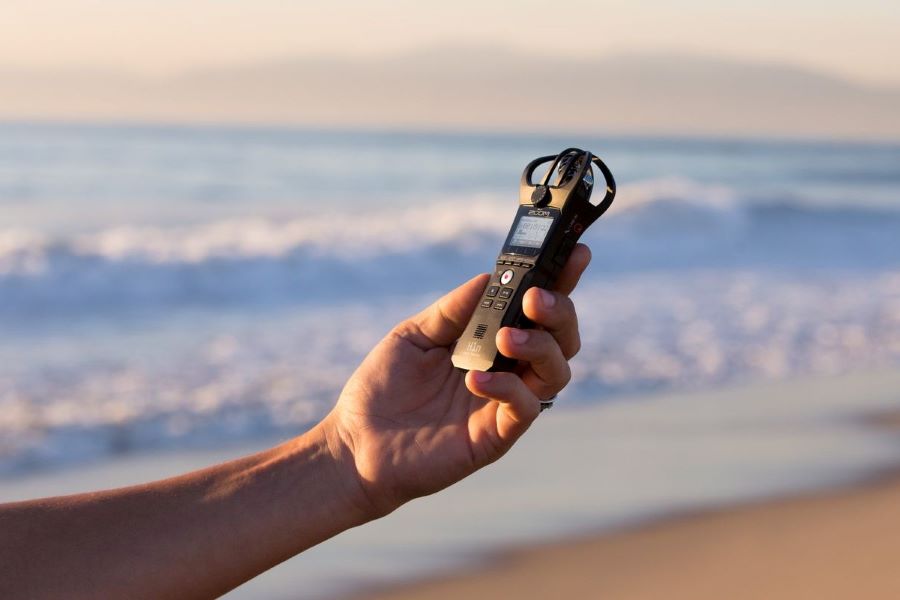The Zoom H1n is a stereo voice recorder offering a small, lightweight experience that goes with you almost anywhere. It works well for one-on-one interviews, focus group conversations, and other podcasting research.
It’s essential for anyone who conducts interviews because the audio quality on the Zoom H1n is excellent. You can combine the voice recorder with a lavalier or shotgun microphone to maximize its benefits.
Although the Zoom H1n is versatile, there could be places where some users encounter different advantages and disadvantages to manage. Here’s a closer look at the voice recorder and what to expect from it.
Related: Zoom H2n vs. Zoom H1n: How Do They Differ?
Contents
How Portable Is the Zoom H1n?
The Zoom H1n voice recorder is one of the smallest voice recorders for podcasters to use in the industry today. It only requires two AAA batteries to deliver the power you need for recording a conversation to broadcast later.
Zoom says that new alkaline batteries in the H1n deliver up to ten hours of support, even if you require continuous recording.
There is also an option to use an AC adapter that plugs into a standard receptacle. This feature is sold separately.
The design only weighs three ounces when it has the batteries it needs for power. That makes it possible to carry the voice recorder in your purse or pocket without feeling uncomfortable.
How Good Is the Sound Quality from the Zoom H1n?

A hand holding a Zoom H1n handy recorder. Image Source.
The Zoom H1n uses dual unidirectional condenser microphones with its default setup. The mics come set at a 90-degree angle with the X/Y technique, ensuring the voice recorder remains sensitive to sounds in the surrounding environment.
This design also causes the Zoom H1n to pick up ambient sounds in the environment. Unless you’re using an external microphone that eliminates this chatter, your interview must be conducted in a studio-like space to remove the unwanted noise.
You have the option to reduce background noise in your DAW or podcast editor, but that work takes extra time to complete.
The accessory pack for the Zoom H1n includes an adapter to use as a handle for the equipment. This feature significantly reduces the handling noises the equipment picks up.
Related: How to Remove Background Noise & Static in Audacity
Does the H1n Come with a Noise Filter?
The Zoom H1n has a noise filter as part of its standard setup. Although it eliminates wind noise and some plosives from an interview, it doesn’t have the power to remove loud environmental sounds from the recording.
You will want to have a windscreen available if you’re interviewing someone during a windy day for your podcast. This option is available in the accessory pack.
The best option for recording with the Zoom H1n when you have plenty of noise pollution to counter is to use a lavalier microphone. Another choice would be to hold the equipment right up to the interviewee as they speak.
How Good Is the Playback with the Zoom H1n?
When you record interviews for podcasts, it helps to play the audio back before sending it to your preferred editing platform to ensure you got what you need.
The H1n provides a built-in speaker on the front of the recorder. There’s a headphone jack on the side, which includes volume control, to help you monitor the audio as it records.
If you don’t have an editor, the Zoom H1n comes with Steinberg WaveLab LE software to ensure you can maximize the value of this investment.
What Are the Storage Options for the Zoom H1n?
The Zoom H1n doesn’t have built-in memory as an included feature. You record interviews for podcasting directly to a micro-SD (mSD) card that must be purchased separately.
It supports mSD cards up to 32 GB for recording audio. The H1n also provides a USB 2.0 port for added convenience, allowing you to use the equipment as a USB microphone when needed.
The audio you record with this voice recorder saves in MP3 or WAV formats. If you’re investing in the H1n for podcasting, you’ll want to choose the latter to avoid fidelity issues. You’ll get about 32 hours of audio on the largest mSD card the equipment supports.
If you record in MP3, you’ll receive over 15 hours of audio for every gigabyte of storage you purchase to use with this voice recorder.
Related: 5 Best Podcast Recorders For Capturing High-Quality Audio
Final Thoughts on the Zoom H1n Voice Recorder
Overall, the Zoom H1n is an excellent choice for recording interviews. It delivers high-quality recordings that you can easily transfer into a podcast or for other broadcasting needs.
The one issue that could be improved involves file management. There isn’t a way to skip to your next recording when you have multiple interviews saved. The only choices are to rewind or fast-forward, which makes the equipment feel a bit like a cassette deck.
For its price, finding lightweight equipment with excellent audio recording qualities is rare. If you’re getting into podcasting, are a journalist who does remote interviews, or a blogger expanding content options, the Zoom H1n will help you achieve your goals.
Related: Zoom H6 Best Settings for Audio Recording: Get Studio-Quality Results